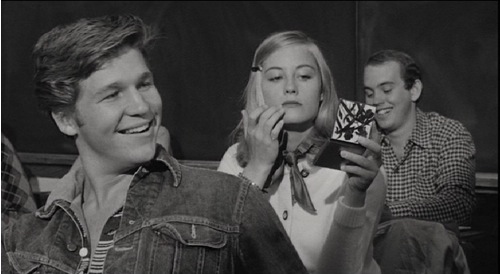by Eric Blume
This month, Filmstruck offers up the one-two-three early 1970s punch of director Peter Bogdanovich. Can you think of any other filmmaker who made three such incredible pictures within a three-year period, only to fade into a disastrous career afterwards?

1971’s The Last Picture Show holds up incredibly well, and ranks as one of the decade’s finest pictures. This film about various lonely souls who have no clue how to connect still resonates powerfully, partially because Bodganovich is unapologetically “adult” in his handling of these story strands. Nothing feels watered-down or soft, and all the characters have edges that make them specific and interesting. Ben Johnson and Cloris Leachman deservedly won supporting Oscars that year for their fine performances, but everyone in the cast delivers beautiful work. There’s a simplicity to the acting, in the best sense: everybody just “is”. Bodganovich has confidence with the material, and he’s passionate about the storytelling. There’s a lingering sadness about the picture that feels distinct in tone, matched perfectly to Larry McMurtry’s original prose and to the characters.

1972’s What’s Up Doc? remains a minor comic miracle. It features Ryan O’Neal at his most handsome and Barbra Streisand at her most sexy, and their chemistry is undeniable. The film makes you lament Streisand’s need to turn so serious onscreen, because her gifts for comedy were untouchable in this earliest phase of her career, and she’s never seemed more free or relaxed. One of the most interesting and compelling aspects of What’s Up Doc? is that it’s a screwball comedy, but it’s directed at a very leisurely pace. Again, Bogdanovich doesn’t rush the piece, and nothing feels frenetic. The switched-suitcase premise simply serves as a launchpad for the more compelling force behind screwball comedies: women who are smarter than men about love. Streisand’s sly pursuit of O’Neal, and the broad but hilarious turn from Madeline Kahn as the other woman, still lands as deeply joyful.

1973’s Paper Moon famously made Tatum O’Neal the youngest competitive Oscar winner ever (discussed on the Smackdown last year). Her performance, as well as the return engagements of O’Neal and Kahn, holds up solidly, although the film doesn’t feel like much of a comedy these days. Instead, the Depression-era setting lends a true melancholy to the proceedings, and the laughs aren’t big. You feel the pain of Tatum’s little Addie, who wants and needs Ryan to be her dad. Perhaps the real-life circumstances lead one to read the movie that way these days?
The common thread of Bogdanovich’s direction of these three films is his assurance. He’s picked strong stories and hired great actors, and he confidently keeps everything on course. His films seem effortless, yet his skill remains inimitable. These are three very different films, yet Bogdanovich deftly unveils the beauty in each. You sense his inspiration, as if he’s eager to share what happened on set everyday with the audience. There’s pleasure and panache in his filmmaking, but in an unshowy way. It’s a shame that he made so many poor choices after these three films, but few artists have a run as exquisite as this one.